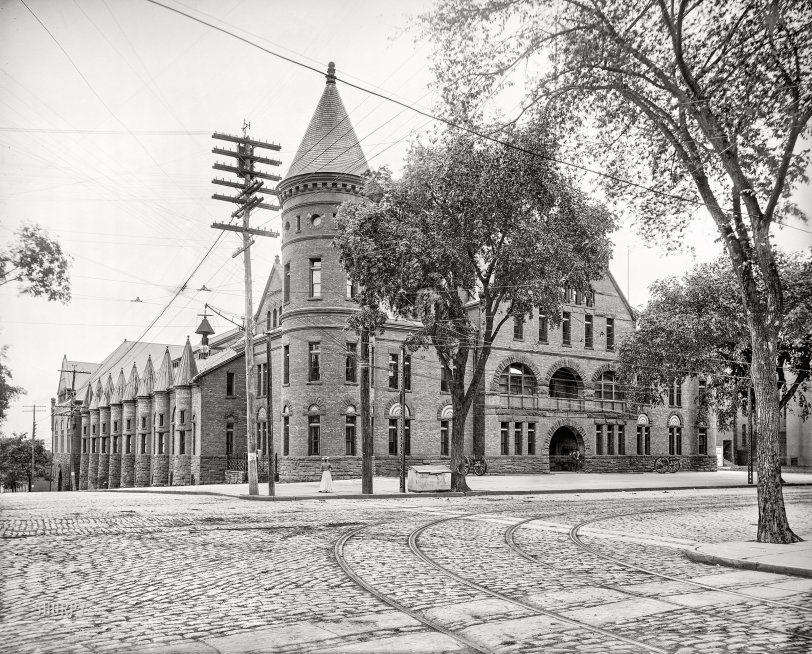


Framed or unframed, desk size to sofa size, printed by us in Arizona and Alabama since 2007. Explore now.
Shorpy is funded by you. Patreon contributors get an ad-free experience.
Learn more.

- Baldwin 62303
- Baldwin VO-1000
- Cold
- No expense spared
- Tough Guys
- Lost in Toyland
- And without gloves
- If I were a blindfolded time traveler
- Smoke Consumer Also Cooks
- Oh that stove!
- Possibly still there?
- What?!?
- $100 Reward
- Freeze Frame
- Texas Flyer wanted
- Just a Year Too Soon
- WWII -- Replacing men with women at the railroad crossing.
- Yes, Icing
- You kids drive me nuts!
- NOT An Easy Job
- I wonder
- Just add window boxes
- Icing Platform?
- Indiana Harbor Belt abides
- Freezing haze
- Corrections (for those who care)
- C&NW at Nelson
- Fallen Flags
- A dangerous job made worse
- Water Stop
Print Emporium
Albany Armory: 1905

Albany, New York, circa 1905. "Armory, 10th Battalion, New York National Guard." 8x10 inch dry plate glass negative, Detroit Photographic Company. View full size.
The purpose for so many armories built in the 1890s
Not a coincidence that so many of these red-brick castles sprang up in that era: fear of immigrants, labor unrest, the Panic of '93, an influenza pandemic, anarchists bombing and killing European royalty and William McKinley. State governments constructed armories against the threat, and middle class men gathered inside them to exercise with Indian clubs and drill with Krag-Jorgensens. Walt Disney later portrayed this as an era of hayrides, ice cream socials and barbershop quartets, but really; the more things change the more they stay the same.
Power Lines II
The three lines are transmission lines for electricity at high voltage. Many utilities have relocated distribution lines (those that provide electricity to consumers) to underground conduits.
Unsightly Telephone lines
Back in the good old days each phone line had it's own discrete wire. The more subscribers the more lines. Eventually, they figured out to use smaller wire in large bundles and 75 years ago they started multiplexing, hence one wire could carry the bandwidth of several. So it's not power lines you see, its telephone wires.
Communication lines
What VicS is seeing are mostly communication lines, for telephone and telegraph. These were two steel wires, uninsulated, for each device on the network. They needed to be separated since they ere uninsulated, and quite large to stand the strain of suspension between poles. More modern systems used copper wires, covered with insulation, in twisted pairs, the pairs bundled into cables.
Telephone wires, etc.
Those multiple crossbars with multiple wires were for telephone lines, not electric power. More recently they were bundled into cables. And, of course, now we have coaxial cables and fiber optic cables replacing telephone bundled wire cables. Now power lines are always at the top of the poles. High voltage above and stepped down to 120/240 volts below. Phone and cable TV are below that.
re Power Lines
Perhaps the poles in the old photogrphs carry telephone/telegraph lines ?
Telephone, not power!
The many lines on the poles are telephone lines, not power lines I believe. They didn't have the multiplexing or thick cables of later years.
Best thing is undergounding though.
Power Lines
One thing I have noticed on almost all of these old photos of city scene there are a lot more power lines strung across multiple cross-ties on the poles. The power lines we have now usually only have three lines with one cross-tie on the poles. I wonder why that is?
When patriotism was fashionable
Prior to 1903, each state essentially had their very own "army", (ie., 'the militia') controlled by the governor. Consequently, the equipage/training of each state's militia depended on the amount of money available in that state. Consequently, the states with the most (tax) money, were rather extravagant in the buildings they erected, to say nothing of the amount they spent on uniforms and equipment. Poorer states purchased cast off/obsolete/surplus U.S. Army equipment.
In 1903, the Dick Act was passed. The Federal Government would supply each state's militia with the then current U.S. Army equipment, and pay for the monthly training / summer camp of each unit. The catch was that the Federal Government could now call up state militia units when a national emergency was declared. Prior to this, each state's militia could only enter Federal service if they "volunteered" to do so.
























On Shorpy:
Today’s Top 5